Examining the Relationship: Amazon's Culture, Behavior, HRM
VerifiedAdded on 2023/06/09
|24
|9909
|242
Thesis and Dissertation
AI Summary
This research project investigates the relationship between organizational culture, organizational behavior, and human resource management within Amazon. The study begins with an introduction highlighting the importance of these elements in improving business performance and efficiency. A comprehensive literature review explores the concepts and theories of organizational culture, behavior, and HRM, examining their impact on Amazon's performance and productivity. The review synthesizes existing research and positions the student's inquiry within the broader academic context. The research examines how Amazon manages employee behavior and attitudes to foster a positive organizational culture. The project aims to identify strategies for improving employee behavior and maintaining a positive culture, ultimately contributing to enhanced business outcomes. The research uses secondary sources, including articles, journals, and online resources, to gather relevant information, providing a cost-effective and time-saving approach to data collection. The study also discusses the roles and responsibilities of HRM within Amazon, including recruitment, training, and employee development. The project concludes by highlighting the importance of aligning organizational culture with organizational objectives to improve overall work output and employee productivity.
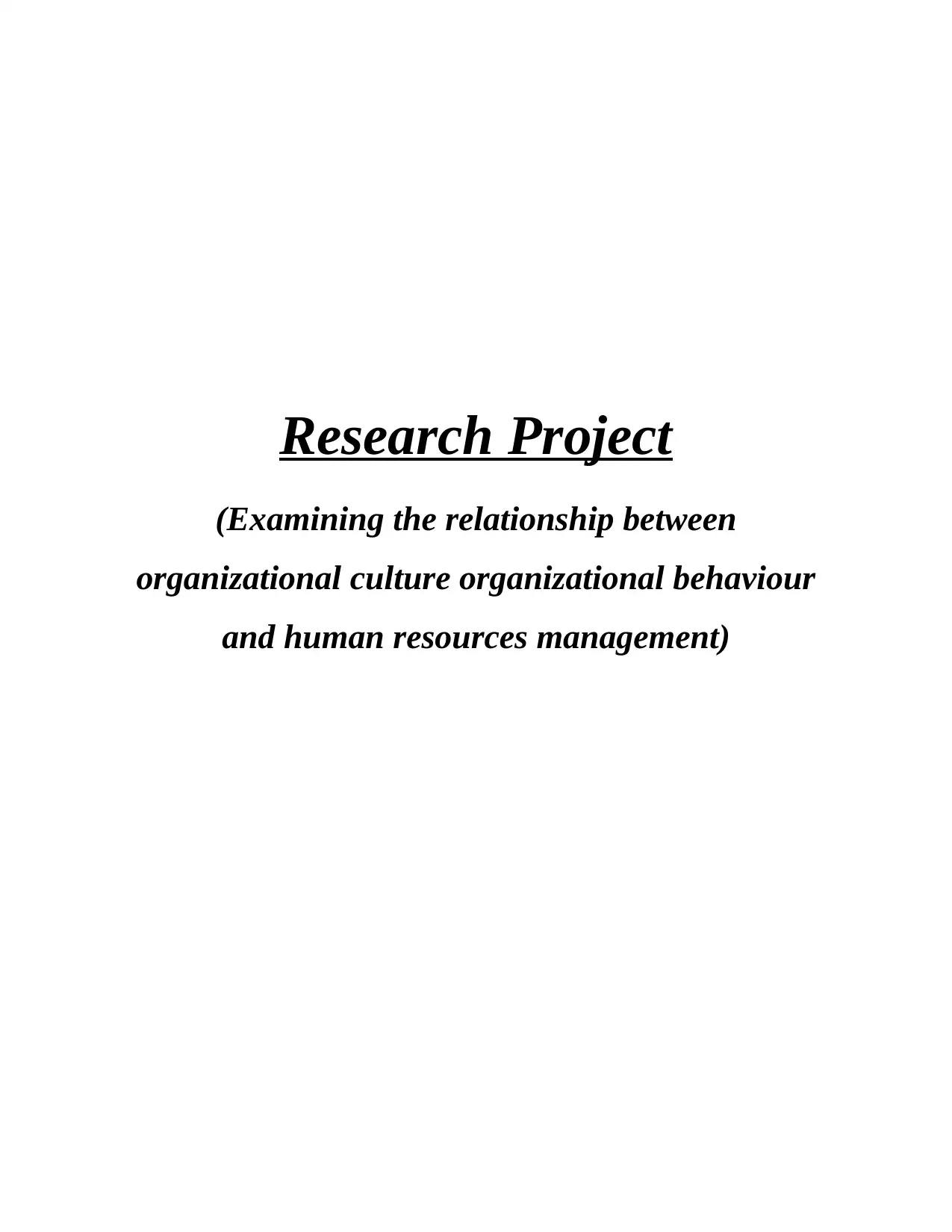
Research Project
(Examining the relationship between
organizational culture organizational behaviour
and human resources management)
(Examining the relationship between
organizational culture organizational behaviour
and human resources management)
Paraphrase This Document
Need a fresh take? Get an instant paraphrase of this document with our AI Paraphraser
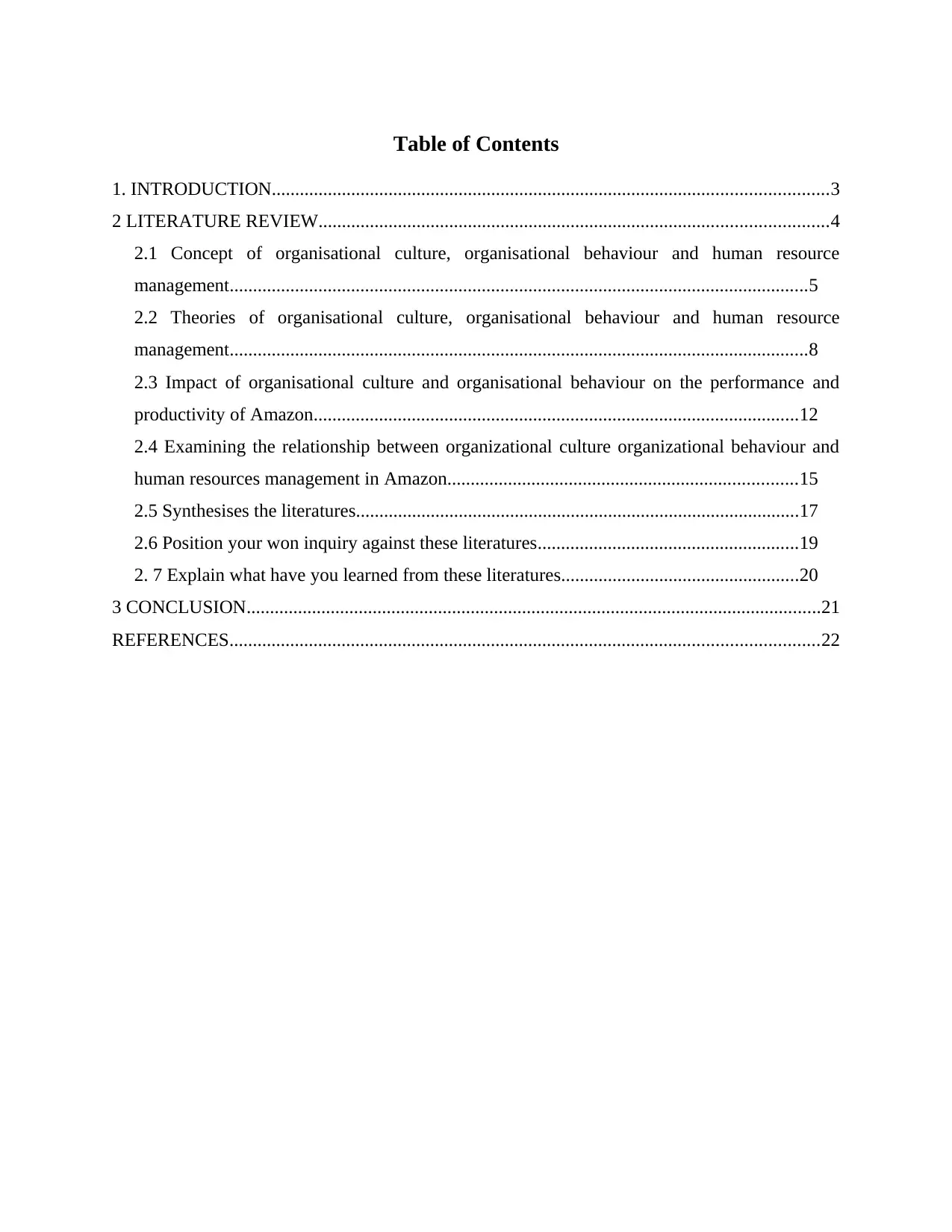
Table of Contents
1. INTRODUCTION.......................................................................................................................3
2 LITERATURE REVIEW.............................................................................................................4
2.1 Concept of organisational culture, organisational behaviour and human resource
management............................................................................................................................5
2.2 Theories of organisational culture, organisational behaviour and human resource
management............................................................................................................................8
2.3 Impact of organisational culture and organisational behaviour on the performance and
productivity of Amazon........................................................................................................12
2.4 Examining the relationship between organizational culture organizational behaviour and
human resources management in Amazon...........................................................................15
2.5 Synthesises the literatures...............................................................................................17
2.6 Position your won inquiry against these literatures........................................................19
2. 7 Explain what have you learned from these literatures...................................................20
3 CONCLUSION...........................................................................................................................21
REFERENCES..............................................................................................................................22
1. INTRODUCTION.......................................................................................................................3
2 LITERATURE REVIEW.............................................................................................................4
2.1 Concept of organisational culture, organisational behaviour and human resource
management............................................................................................................................5
2.2 Theories of organisational culture, organisational behaviour and human resource
management............................................................................................................................8
2.3 Impact of organisational culture and organisational behaviour on the performance and
productivity of Amazon........................................................................................................12
2.4 Examining the relationship between organizational culture organizational behaviour and
human resources management in Amazon...........................................................................15
2.5 Synthesises the literatures...............................................................................................17
2.6 Position your won inquiry against these literatures........................................................19
2. 7 Explain what have you learned from these literatures...................................................20
3 CONCLUSION...........................................................................................................................21
REFERENCES..............................................................................................................................22
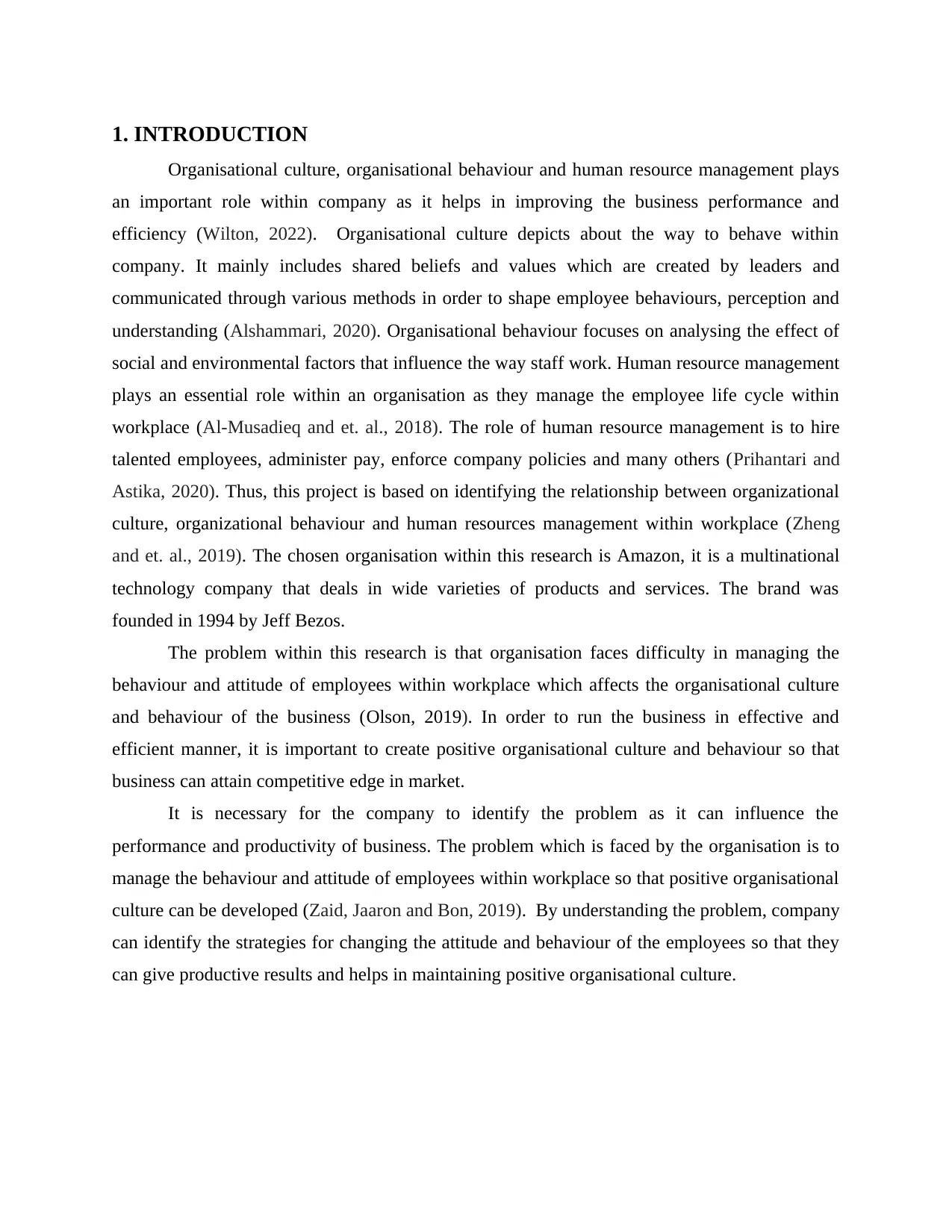
1. INTRODUCTION
Organisational culture, organisational behaviour and human resource management plays
an important role within company as it helps in improving the business performance and
efficiency (Wilton, 2022). Organisational culture depicts about the way to behave within
company. It mainly includes shared beliefs and values which are created by leaders and
communicated through various methods in order to shape employee behaviours, perception and
understanding (Alshammari, 2020). Organisational behaviour focuses on analysing the effect of
social and environmental factors that influence the way staff work. Human resource management
plays an essential role within an organisation as they manage the employee life cycle within
workplace (Al-Musadieq and et. al., 2018). The role of human resource management is to hire
talented employees, administer pay, enforce company policies and many others (Prihantari and
Astika, 2020). Thus, this project is based on identifying the relationship between organizational
culture, organizational behaviour and human resources management within workplace (Zheng
and et. al., 2019). The chosen organisation within this research is Amazon, it is a multinational
technology company that deals in wide varieties of products and services. The brand was
founded in 1994 by Jeff Bezos.
The problem within this research is that organisation faces difficulty in managing the
behaviour and attitude of employees within workplace which affects the organisational culture
and behaviour of the business (Olson, 2019). In order to run the business in effective and
efficient manner, it is important to create positive organisational culture and behaviour so that
business can attain competitive edge in market.
It is necessary for the company to identify the problem as it can influence the
performance and productivity of business. The problem which is faced by the organisation is to
manage the behaviour and attitude of employees within workplace so that positive organisational
culture can be developed (Zaid, Jaaron and Bon, 2019). By understanding the problem, company
can identify the strategies for changing the attitude and behaviour of the employees so that they
can give productive results and helps in maintaining positive organisational culture.
Organisational culture, organisational behaviour and human resource management plays
an important role within company as it helps in improving the business performance and
efficiency (Wilton, 2022). Organisational culture depicts about the way to behave within
company. It mainly includes shared beliefs and values which are created by leaders and
communicated through various methods in order to shape employee behaviours, perception and
understanding (Alshammari, 2020). Organisational behaviour focuses on analysing the effect of
social and environmental factors that influence the way staff work. Human resource management
plays an essential role within an organisation as they manage the employee life cycle within
workplace (Al-Musadieq and et. al., 2018). The role of human resource management is to hire
talented employees, administer pay, enforce company policies and many others (Prihantari and
Astika, 2020). Thus, this project is based on identifying the relationship between organizational
culture, organizational behaviour and human resources management within workplace (Zheng
and et. al., 2019). The chosen organisation within this research is Amazon, it is a multinational
technology company that deals in wide varieties of products and services. The brand was
founded in 1994 by Jeff Bezos.
The problem within this research is that organisation faces difficulty in managing the
behaviour and attitude of employees within workplace which affects the organisational culture
and behaviour of the business (Olson, 2019). In order to run the business in effective and
efficient manner, it is important to create positive organisational culture and behaviour so that
business can attain competitive edge in market.
It is necessary for the company to identify the problem as it can influence the
performance and productivity of business. The problem which is faced by the organisation is to
manage the behaviour and attitude of employees within workplace so that positive organisational
culture can be developed (Zaid, Jaaron and Bon, 2019). By understanding the problem, company
can identify the strategies for changing the attitude and behaviour of the employees so that they
can give productive results and helps in maintaining positive organisational culture.
⊘ This is a preview!⊘
Do you want full access?
Subscribe today to unlock all pages.

Trusted by 1+ million students worldwide
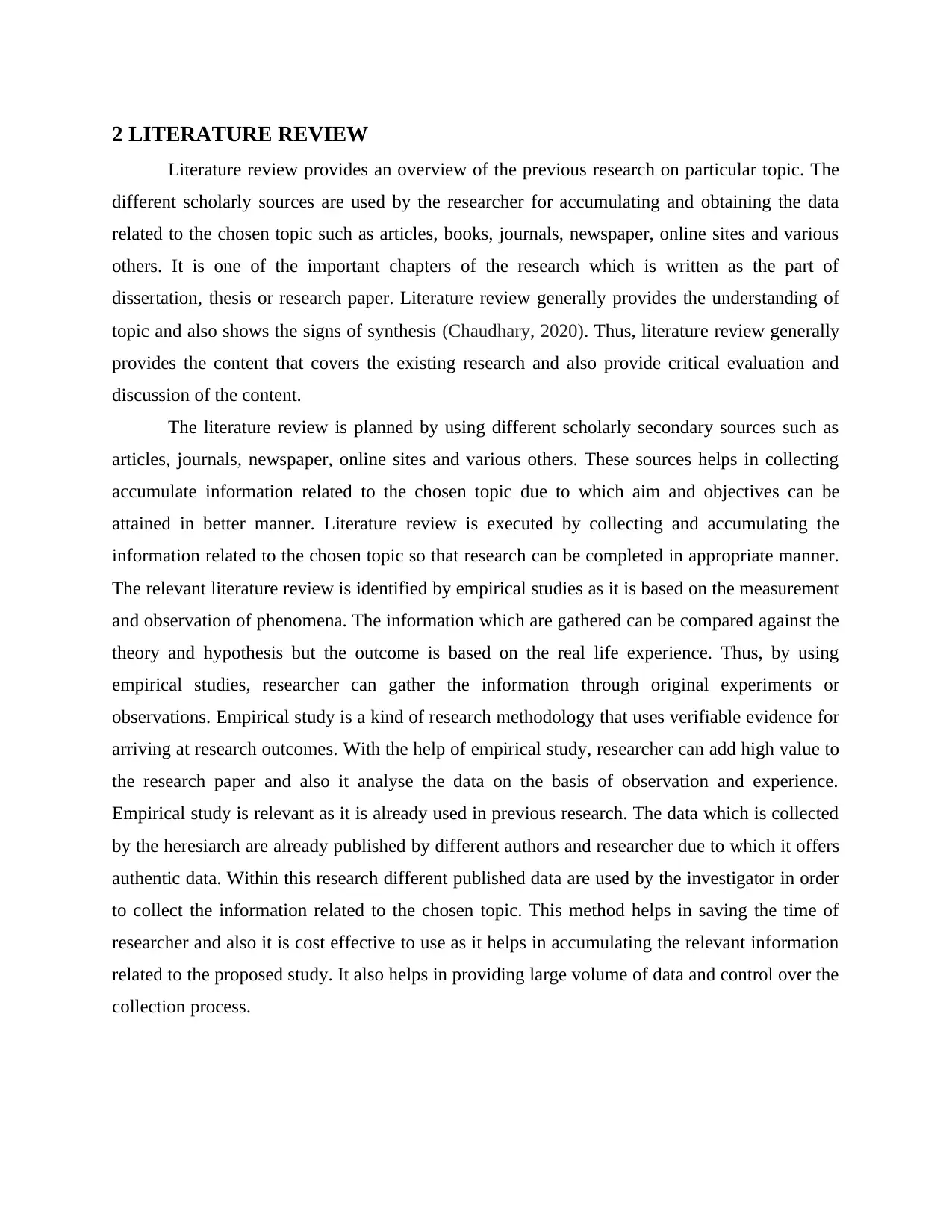
2 LITERATURE REVIEW
Literature review provides an overview of the previous research on particular topic. The
different scholarly sources are used by the researcher for accumulating and obtaining the data
related to the chosen topic such as articles, books, journals, newspaper, online sites and various
others. It is one of the important chapters of the research which is written as the part of
dissertation, thesis or research paper. Literature review generally provides the understanding of
topic and also shows the signs of synthesis (Chaudhary, 2020). Thus, literature review generally
provides the content that covers the existing research and also provide critical evaluation and
discussion of the content.
The literature review is planned by using different scholarly secondary sources such as
articles, journals, newspaper, online sites and various others. These sources helps in collecting
accumulate information related to the chosen topic due to which aim and objectives can be
attained in better manner. Literature review is executed by collecting and accumulating the
information related to the chosen topic so that research can be completed in appropriate manner.
The relevant literature review is identified by empirical studies as it is based on the measurement
and observation of phenomena. The information which are gathered can be compared against the
theory and hypothesis but the outcome is based on the real life experience. Thus, by using
empirical studies, researcher can gather the information through original experiments or
observations. Empirical study is a kind of research methodology that uses verifiable evidence for
arriving at research outcomes. With the help of empirical study, researcher can add high value to
the research paper and also it analyse the data on the basis of observation and experience.
Empirical study is relevant as it is already used in previous research. The data which is collected
by the heresiarch are already published by different authors and researcher due to which it offers
authentic data. Within this research different published data are used by the investigator in order
to collect the information related to the chosen topic. This method helps in saving the time of
researcher and also it is cost effective to use as it helps in accumulating the relevant information
related to the proposed study. It also helps in providing large volume of data and control over the
collection process.
Literature review provides an overview of the previous research on particular topic. The
different scholarly sources are used by the researcher for accumulating and obtaining the data
related to the chosen topic such as articles, books, journals, newspaper, online sites and various
others. It is one of the important chapters of the research which is written as the part of
dissertation, thesis or research paper. Literature review generally provides the understanding of
topic and also shows the signs of synthesis (Chaudhary, 2020). Thus, literature review generally
provides the content that covers the existing research and also provide critical evaluation and
discussion of the content.
The literature review is planned by using different scholarly secondary sources such as
articles, journals, newspaper, online sites and various others. These sources helps in collecting
accumulate information related to the chosen topic due to which aim and objectives can be
attained in better manner. Literature review is executed by collecting and accumulating the
information related to the chosen topic so that research can be completed in appropriate manner.
The relevant literature review is identified by empirical studies as it is based on the measurement
and observation of phenomena. The information which are gathered can be compared against the
theory and hypothesis but the outcome is based on the real life experience. Thus, by using
empirical studies, researcher can gather the information through original experiments or
observations. Empirical study is a kind of research methodology that uses verifiable evidence for
arriving at research outcomes. With the help of empirical study, researcher can add high value to
the research paper and also it analyse the data on the basis of observation and experience.
Empirical study is relevant as it is already used in previous research. The data which is collected
by the heresiarch are already published by different authors and researcher due to which it offers
authentic data. Within this research different published data are used by the investigator in order
to collect the information related to the chosen topic. This method helps in saving the time of
researcher and also it is cost effective to use as it helps in accumulating the relevant information
related to the proposed study. It also helps in providing large volume of data and control over the
collection process.
Paraphrase This Document
Need a fresh take? Get an instant paraphrase of this document with our AI Paraphraser
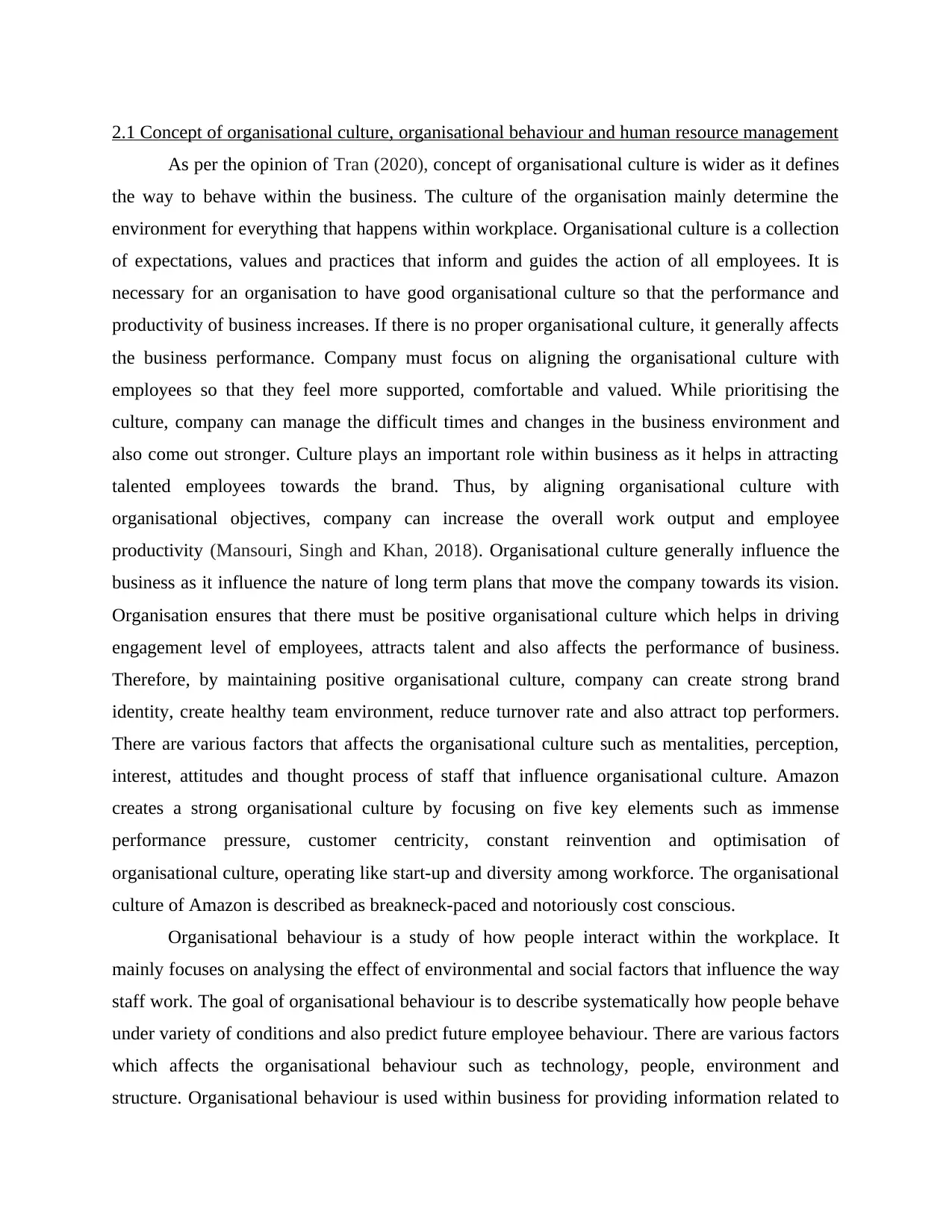
2.1 Concept of organisational culture, organisational behaviour and human resource management
As per the opinion of Tran (2020), concept of organisational culture is wider as it defines
the way to behave within the business. The culture of the organisation mainly determine the
environment for everything that happens within workplace. Organisational culture is a collection
of expectations, values and practices that inform and guides the action of all employees. It is
necessary for an organisation to have good organisational culture so that the performance and
productivity of business increases. If there is no proper organisational culture, it generally affects
the business performance. Company must focus on aligning the organisational culture with
employees so that they feel more supported, comfortable and valued. While prioritising the
culture, company can manage the difficult times and changes in the business environment and
also come out stronger. Culture plays an important role within business as it helps in attracting
talented employees towards the brand. Thus, by aligning organisational culture with
organisational objectives, company can increase the overall work output and employee
productivity (Mansouri, Singh and Khan, 2018). Organisational culture generally influence the
business as it influence the nature of long term plans that move the company towards its vision.
Organisation ensures that there must be positive organisational culture which helps in driving
engagement level of employees, attracts talent and also affects the performance of business.
Therefore, by maintaining positive organisational culture, company can create strong brand
identity, create healthy team environment, reduce turnover rate and also attract top performers.
There are various factors that affects the organisational culture such as mentalities, perception,
interest, attitudes and thought process of staff that influence organisational culture. Amazon
creates a strong organisational culture by focusing on five key elements such as immense
performance pressure, customer centricity, constant reinvention and optimisation of
organisational culture, operating like start-up and diversity among workforce. The organisational
culture of Amazon is described as breakneck-paced and notoriously cost conscious.
Organisational behaviour is a study of how people interact within the workplace. It
mainly focuses on analysing the effect of environmental and social factors that influence the way
staff work. The goal of organisational behaviour is to describe systematically how people behave
under variety of conditions and also predict future employee behaviour. There are various factors
which affects the organisational behaviour such as technology, people, environment and
structure. Organisational behaviour is used within business for providing information related to
As per the opinion of Tran (2020), concept of organisational culture is wider as it defines
the way to behave within the business. The culture of the organisation mainly determine the
environment for everything that happens within workplace. Organisational culture is a collection
of expectations, values and practices that inform and guides the action of all employees. It is
necessary for an organisation to have good organisational culture so that the performance and
productivity of business increases. If there is no proper organisational culture, it generally affects
the business performance. Company must focus on aligning the organisational culture with
employees so that they feel more supported, comfortable and valued. While prioritising the
culture, company can manage the difficult times and changes in the business environment and
also come out stronger. Culture plays an important role within business as it helps in attracting
talented employees towards the brand. Thus, by aligning organisational culture with
organisational objectives, company can increase the overall work output and employee
productivity (Mansouri, Singh and Khan, 2018). Organisational culture generally influence the
business as it influence the nature of long term plans that move the company towards its vision.
Organisation ensures that there must be positive organisational culture which helps in driving
engagement level of employees, attracts talent and also affects the performance of business.
Therefore, by maintaining positive organisational culture, company can create strong brand
identity, create healthy team environment, reduce turnover rate and also attract top performers.
There are various factors that affects the organisational culture such as mentalities, perception,
interest, attitudes and thought process of staff that influence organisational culture. Amazon
creates a strong organisational culture by focusing on five key elements such as immense
performance pressure, customer centricity, constant reinvention and optimisation of
organisational culture, operating like start-up and diversity among workforce. The organisational
culture of Amazon is described as breakneck-paced and notoriously cost conscious.
Organisational behaviour is a study of how people interact within the workplace. It
mainly focuses on analysing the effect of environmental and social factors that influence the way
staff work. The goal of organisational behaviour is to describe systematically how people behave
under variety of conditions and also predict future employee behaviour. There are various factors
which affects the organisational behaviour such as technology, people, environment and
structure. Organisational behaviour is used within business for providing information related to
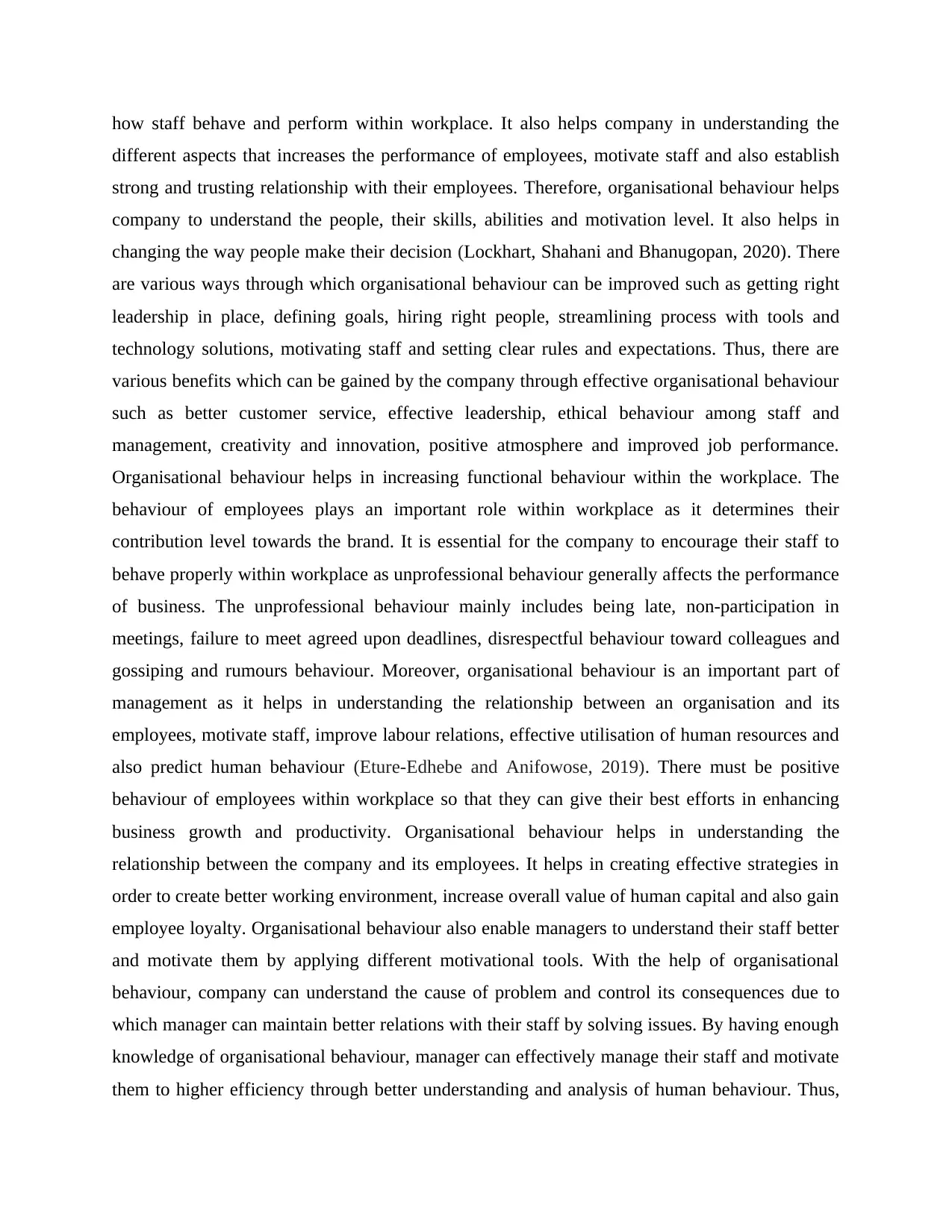
how staff behave and perform within workplace. It also helps company in understanding the
different aspects that increases the performance of employees, motivate staff and also establish
strong and trusting relationship with their employees. Therefore, organisational behaviour helps
company to understand the people, their skills, abilities and motivation level. It also helps in
changing the way people make their decision (Lockhart, Shahani and Bhanugopan, 2020). There
are various ways through which organisational behaviour can be improved such as getting right
leadership in place, defining goals, hiring right people, streamlining process with tools and
technology solutions, motivating staff and setting clear rules and expectations. Thus, there are
various benefits which can be gained by the company through effective organisational behaviour
such as better customer service, effective leadership, ethical behaviour among staff and
management, creativity and innovation, positive atmosphere and improved job performance.
Organisational behaviour helps in increasing functional behaviour within the workplace. The
behaviour of employees plays an important role within workplace as it determines their
contribution level towards the brand. It is essential for the company to encourage their staff to
behave properly within workplace as unprofessional behaviour generally affects the performance
of business. The unprofessional behaviour mainly includes being late, non-participation in
meetings, failure to meet agreed upon deadlines, disrespectful behaviour toward colleagues and
gossiping and rumours behaviour. Moreover, organisational behaviour is an important part of
management as it helps in understanding the relationship between an organisation and its
employees, motivate staff, improve labour relations, effective utilisation of human resources and
also predict human behaviour (Eture-Edhebe and Anifowose, 2019). There must be positive
behaviour of employees within workplace so that they can give their best efforts in enhancing
business growth and productivity. Organisational behaviour helps in understanding the
relationship between the company and its employees. It helps in creating effective strategies in
order to create better working environment, increase overall value of human capital and also gain
employee loyalty. Organisational behaviour also enable managers to understand their staff better
and motivate them by applying different motivational tools. With the help of organisational
behaviour, company can understand the cause of problem and control its consequences due to
which manager can maintain better relations with their staff by solving issues. By having enough
knowledge of organisational behaviour, manager can effectively manage their staff and motivate
them to higher efficiency through better understanding and analysis of human behaviour. Thus,
different aspects that increases the performance of employees, motivate staff and also establish
strong and trusting relationship with their employees. Therefore, organisational behaviour helps
company to understand the people, their skills, abilities and motivation level. It also helps in
changing the way people make their decision (Lockhart, Shahani and Bhanugopan, 2020). There
are various ways through which organisational behaviour can be improved such as getting right
leadership in place, defining goals, hiring right people, streamlining process with tools and
technology solutions, motivating staff and setting clear rules and expectations. Thus, there are
various benefits which can be gained by the company through effective organisational behaviour
such as better customer service, effective leadership, ethical behaviour among staff and
management, creativity and innovation, positive atmosphere and improved job performance.
Organisational behaviour helps in increasing functional behaviour within the workplace. The
behaviour of employees plays an important role within workplace as it determines their
contribution level towards the brand. It is essential for the company to encourage their staff to
behave properly within workplace as unprofessional behaviour generally affects the performance
of business. The unprofessional behaviour mainly includes being late, non-participation in
meetings, failure to meet agreed upon deadlines, disrespectful behaviour toward colleagues and
gossiping and rumours behaviour. Moreover, organisational behaviour is an important part of
management as it helps in understanding the relationship between an organisation and its
employees, motivate staff, improve labour relations, effective utilisation of human resources and
also predict human behaviour (Eture-Edhebe and Anifowose, 2019). There must be positive
behaviour of employees within workplace so that they can give their best efforts in enhancing
business growth and productivity. Organisational behaviour helps in understanding the
relationship between the company and its employees. It helps in creating effective strategies in
order to create better working environment, increase overall value of human capital and also gain
employee loyalty. Organisational behaviour also enable managers to understand their staff better
and motivate them by applying different motivational tools. With the help of organisational
behaviour, company can understand the cause of problem and control its consequences due to
which manager can maintain better relations with their staff by solving issues. By having enough
knowledge of organisational behaviour, manager can effectively manage their staff and motivate
them to higher efficiency through better understanding and analysis of human behaviour. Thus,
⊘ This is a preview!⊘
Do you want full access?
Subscribe today to unlock all pages.

Trusted by 1+ million students worldwide
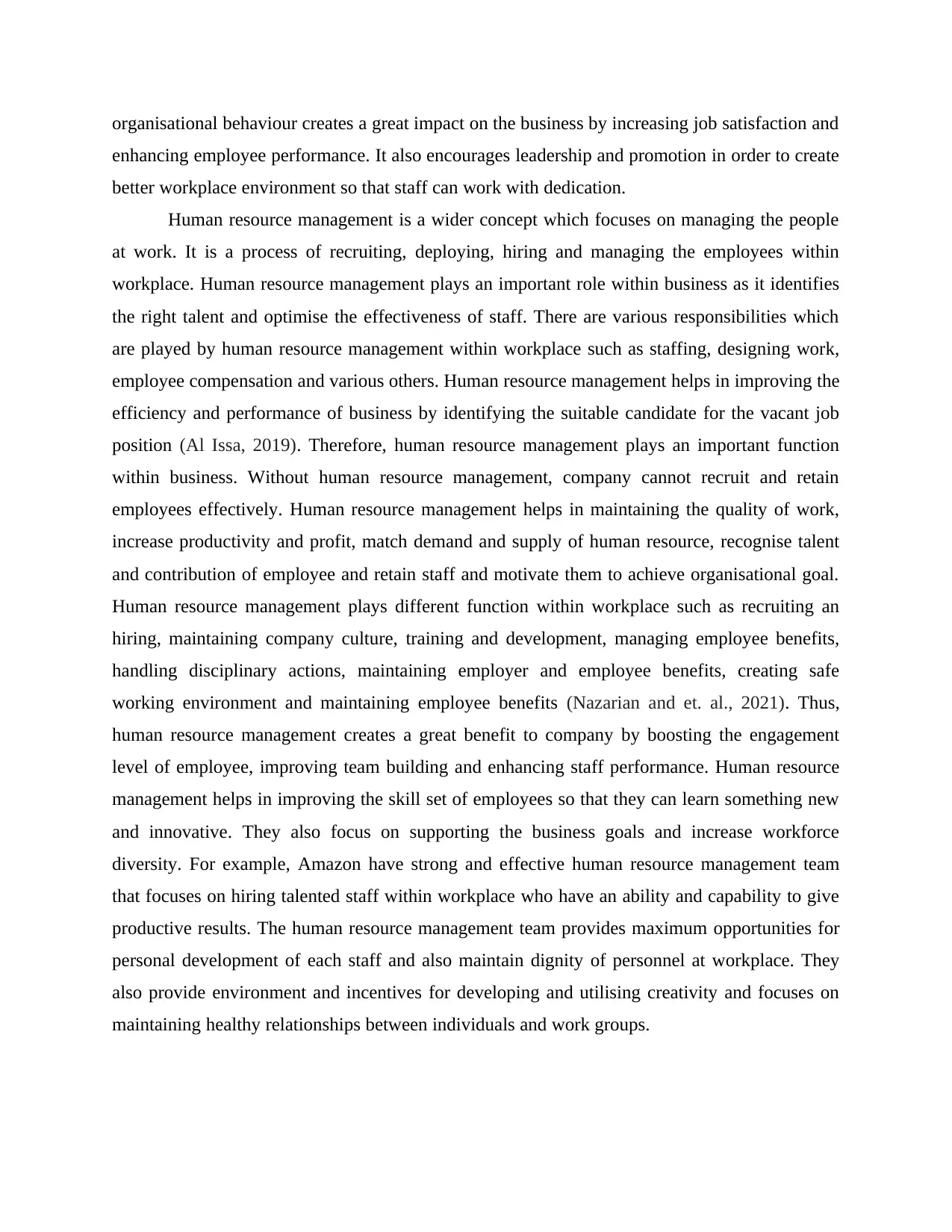
organisational behaviour creates a great impact on the business by increasing job satisfaction and
enhancing employee performance. It also encourages leadership and promotion in order to create
better workplace environment so that staff can work with dedication.
Human resource management is a wider concept which focuses on managing the people
at work. It is a process of recruiting, deploying, hiring and managing the employees within
workplace. Human resource management plays an important role within business as it identifies
the right talent and optimise the effectiveness of staff. There are various responsibilities which
are played by human resource management within workplace such as staffing, designing work,
employee compensation and various others. Human resource management helps in improving the
efficiency and performance of business by identifying the suitable candidate for the vacant job
position (Al Issa, 2019). Therefore, human resource management plays an important function
within business. Without human resource management, company cannot recruit and retain
employees effectively. Human resource management helps in maintaining the quality of work,
increase productivity and profit, match demand and supply of human resource, recognise talent
and contribution of employee and retain staff and motivate them to achieve organisational goal.
Human resource management plays different function within workplace such as recruiting an
hiring, maintaining company culture, training and development, managing employee benefits,
handling disciplinary actions, maintaining employer and employee benefits, creating safe
working environment and maintaining employee benefits (Nazarian and et. al., 2021). Thus,
human resource management creates a great benefit to company by boosting the engagement
level of employee, improving team building and enhancing staff performance. Human resource
management helps in improving the skill set of employees so that they can learn something new
and innovative. They also focus on supporting the business goals and increase workforce
diversity. For example, Amazon have strong and effective human resource management team
that focuses on hiring talented staff within workplace who have an ability and capability to give
productive results. The human resource management team provides maximum opportunities for
personal development of each staff and also maintain dignity of personnel at workplace. They
also provide environment and incentives for developing and utilising creativity and focuses on
maintaining healthy relationships between individuals and work groups.
enhancing employee performance. It also encourages leadership and promotion in order to create
better workplace environment so that staff can work with dedication.
Human resource management is a wider concept which focuses on managing the people
at work. It is a process of recruiting, deploying, hiring and managing the employees within
workplace. Human resource management plays an important role within business as it identifies
the right talent and optimise the effectiveness of staff. There are various responsibilities which
are played by human resource management within workplace such as staffing, designing work,
employee compensation and various others. Human resource management helps in improving the
efficiency and performance of business by identifying the suitable candidate for the vacant job
position (Al Issa, 2019). Therefore, human resource management plays an important function
within business. Without human resource management, company cannot recruit and retain
employees effectively. Human resource management helps in maintaining the quality of work,
increase productivity and profit, match demand and supply of human resource, recognise talent
and contribution of employee and retain staff and motivate them to achieve organisational goal.
Human resource management plays different function within workplace such as recruiting an
hiring, maintaining company culture, training and development, managing employee benefits,
handling disciplinary actions, maintaining employer and employee benefits, creating safe
working environment and maintaining employee benefits (Nazarian and et. al., 2021). Thus,
human resource management creates a great benefit to company by boosting the engagement
level of employee, improving team building and enhancing staff performance. Human resource
management helps in improving the skill set of employees so that they can learn something new
and innovative. They also focus on supporting the business goals and increase workforce
diversity. For example, Amazon have strong and effective human resource management team
that focuses on hiring talented staff within workplace who have an ability and capability to give
productive results. The human resource management team provides maximum opportunities for
personal development of each staff and also maintain dignity of personnel at workplace. They
also provide environment and incentives for developing and utilising creativity and focuses on
maintaining healthy relationships between individuals and work groups.
Paraphrase This Document
Need a fresh take? Get an instant paraphrase of this document with our AI Paraphraser
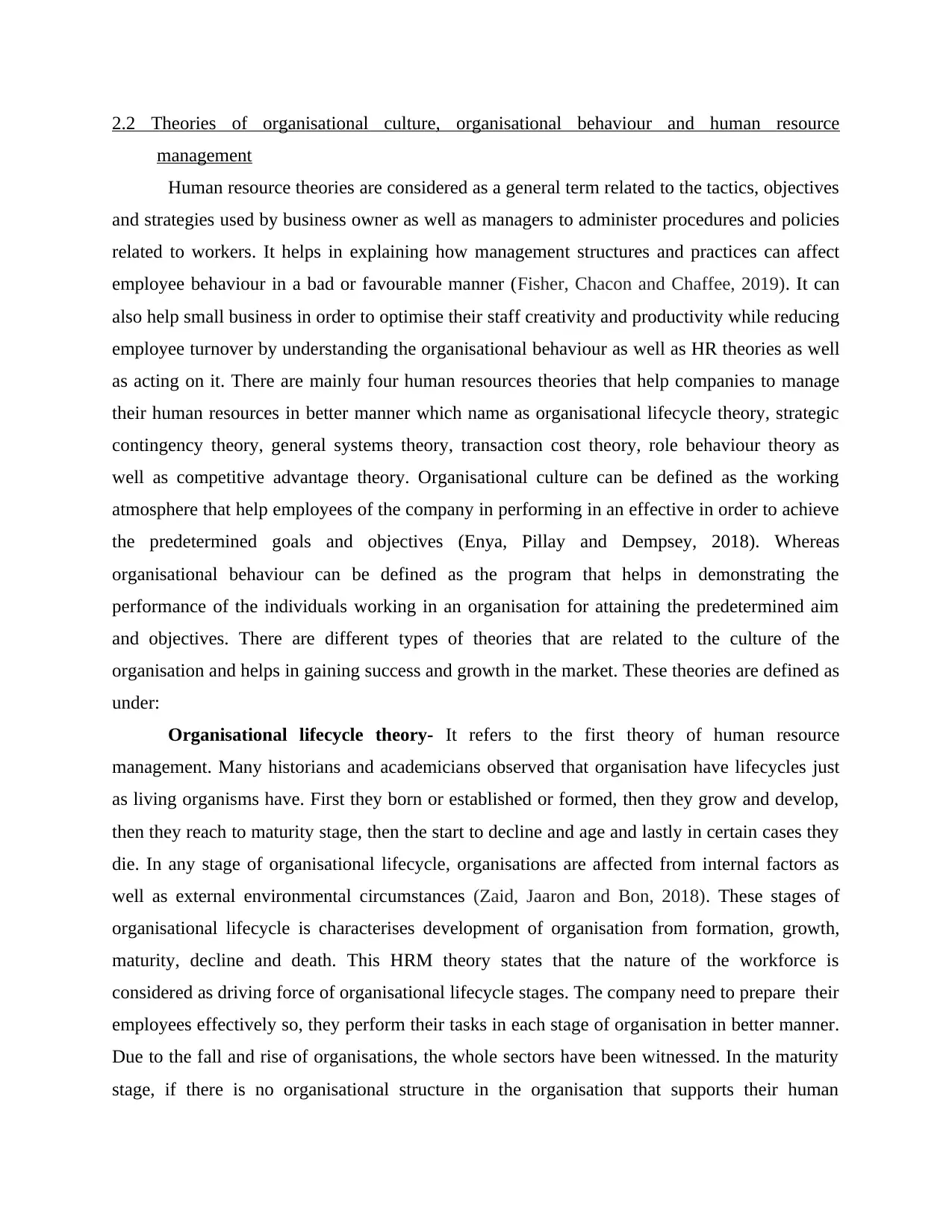
2.2 Theories of organisational culture, organisational behaviour and human resource
management
Human resource theories are considered as a general term related to the tactics, objectives
and strategies used by business owner as well as managers to administer procedures and policies
related to workers. It helps in explaining how management structures and practices can affect
employee behaviour in a bad or favourable manner (Fisher, Chacon and Chaffee, 2019). It can
also help small business in order to optimise their staff creativity and productivity while reducing
employee turnover by understanding the organisational behaviour as well as HR theories as well
as acting on it. There are mainly four human resources theories that help companies to manage
their human resources in better manner which name as organisational lifecycle theory, strategic
contingency theory, general systems theory, transaction cost theory, role behaviour theory as
well as competitive advantage theory. Organisational culture can be defined as the working
atmosphere that help employees of the company in performing in an effective in order to achieve
the predetermined goals and objectives (Enya, Pillay and Dempsey, 2018). Whereas
organisational behaviour can be defined as the program that helps in demonstrating the
performance of the individuals working in an organisation for attaining the predetermined aim
and objectives. There are different types of theories that are related to the culture of the
organisation and helps in gaining success and growth in the market. These theories are defined as
under:
Organisational lifecycle theory- It refers to the first theory of human resource
management. Many historians and academicians observed that organisation have lifecycles just
as living organisms have. First they born or established or formed, then they grow and develop,
then they reach to maturity stage, then the start to decline and age and lastly in certain cases they
die. In any stage of organisational lifecycle, organisations are affected from internal factors as
well as external environmental circumstances (Zaid, Jaaron and Bon, 2018). These stages of
organisational lifecycle is characterises development of organisation from formation, growth,
maturity, decline and death. This HRM theory states that the nature of the workforce is
considered as driving force of organisational lifecycle stages. The company need to prepare their
employees effectively so, they perform their tasks in each stage of organisation in better manner.
Due to the fall and rise of organisations, the whole sectors have been witnessed. In the maturity
stage, if there is no organisational structure in the organisation that supports their human
management
Human resource theories are considered as a general term related to the tactics, objectives
and strategies used by business owner as well as managers to administer procedures and policies
related to workers. It helps in explaining how management structures and practices can affect
employee behaviour in a bad or favourable manner (Fisher, Chacon and Chaffee, 2019). It can
also help small business in order to optimise their staff creativity and productivity while reducing
employee turnover by understanding the organisational behaviour as well as HR theories as well
as acting on it. There are mainly four human resources theories that help companies to manage
their human resources in better manner which name as organisational lifecycle theory, strategic
contingency theory, general systems theory, transaction cost theory, role behaviour theory as
well as competitive advantage theory. Organisational culture can be defined as the working
atmosphere that help employees of the company in performing in an effective in order to achieve
the predetermined goals and objectives (Enya, Pillay and Dempsey, 2018). Whereas
organisational behaviour can be defined as the program that helps in demonstrating the
performance of the individuals working in an organisation for attaining the predetermined aim
and objectives. There are different types of theories that are related to the culture of the
organisation and helps in gaining success and growth in the market. These theories are defined as
under:
Organisational lifecycle theory- It refers to the first theory of human resource
management. Many historians and academicians observed that organisation have lifecycles just
as living organisms have. First they born or established or formed, then they grow and develop,
then they reach to maturity stage, then the start to decline and age and lastly in certain cases they
die. In any stage of organisational lifecycle, organisations are affected from internal factors as
well as external environmental circumstances (Zaid, Jaaron and Bon, 2018). These stages of
organisational lifecycle is characterises development of organisation from formation, growth,
maturity, decline and death. This HRM theory states that the nature of the workforce is
considered as driving force of organisational lifecycle stages. The company need to prepare their
employees effectively so, they perform their tasks in each stage of organisation in better manner.
Due to the fall and rise of organisations, the whole sectors have been witnessed. In the maturity
stage, if there is no organisational structure in the organisation that supports their human
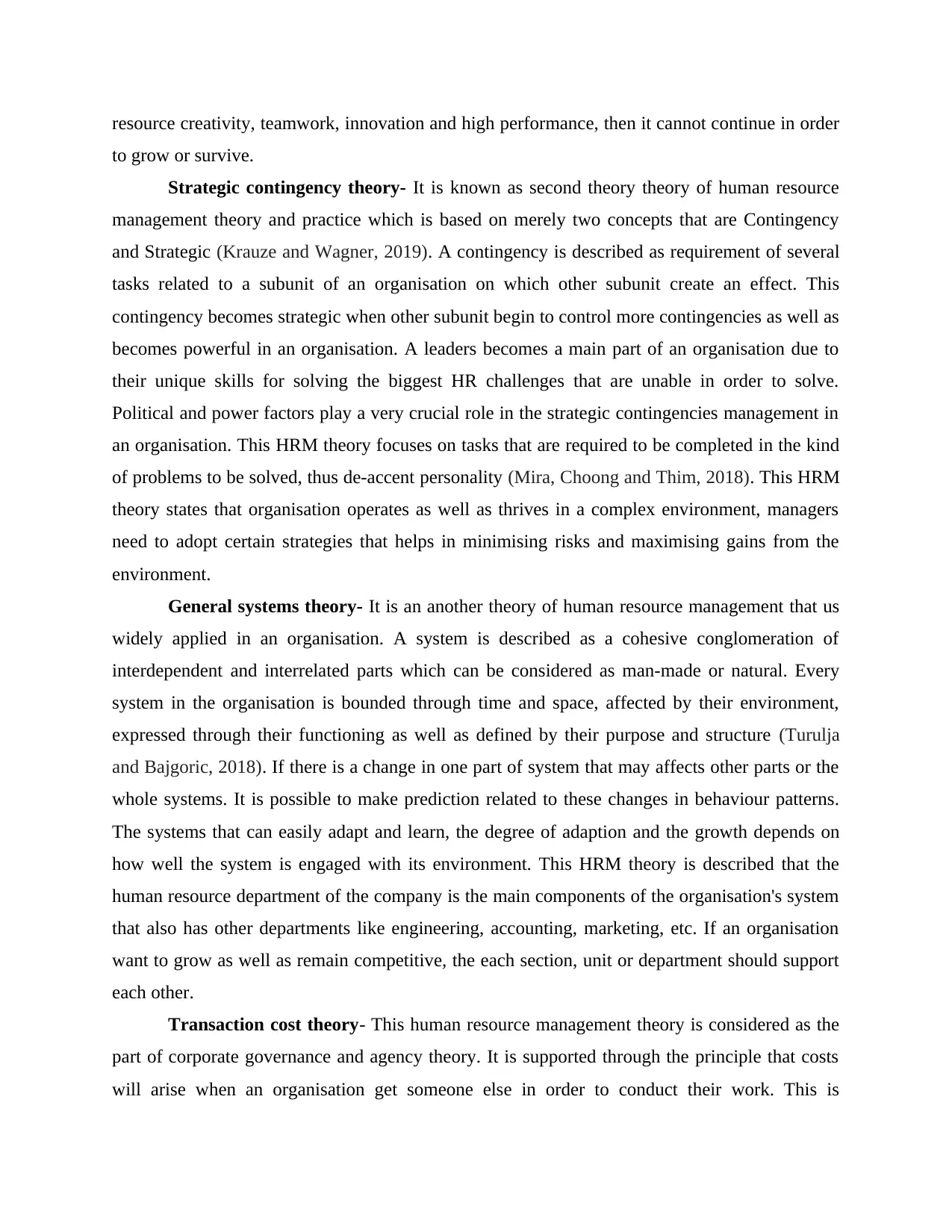
resource creativity, teamwork, innovation and high performance, then it cannot continue in order
to grow or survive.
Strategic contingency theory- It is known as second theory theory of human resource
management theory and practice which is based on merely two concepts that are Contingency
and Strategic (Krauze and Wagner, 2019). A contingency is described as requirement of several
tasks related to a subunit of an organisation on which other subunit create an effect. This
contingency becomes strategic when other subunit begin to control more contingencies as well as
becomes powerful in an organisation. A leaders becomes a main part of an organisation due to
their unique skills for solving the biggest HR challenges that are unable in order to solve.
Political and power factors play a very crucial role in the strategic contingencies management in
an organisation. This HRM theory focuses on tasks that are required to be completed in the kind
of problems to be solved, thus de-accent personality (Mira, Choong and Thim, 2018). This HRM
theory states that organisation operates as well as thrives in a complex environment, managers
need to adopt certain strategies that helps in minimising risks and maximising gains from the
environment.
General systems theory- It is an another theory of human resource management that us
widely applied in an organisation. A system is described as a cohesive conglomeration of
interdependent and interrelated parts which can be considered as man-made or natural. Every
system in the organisation is bounded through time and space, affected by their environment,
expressed through their functioning as well as defined by their purpose and structure (Turulja
and Bajgoric, 2018). If there is a change in one part of system that may affects other parts or the
whole systems. It is possible to make prediction related to these changes in behaviour patterns.
The systems that can easily adapt and learn, the degree of adaption and the growth depends on
how well the system is engaged with its environment. This HRM theory is described that the
human resource department of the company is the main components of the organisation's system
that also has other departments like engineering, accounting, marketing, etc. If an organisation
want to grow as well as remain competitive, the each section, unit or department should support
each other.
Transaction cost theory- This human resource management theory is considered as the
part of corporate governance and agency theory. It is supported through the principle that costs
will arise when an organisation get someone else in order to conduct their work. This is
to grow or survive.
Strategic contingency theory- It is known as second theory theory of human resource
management theory and practice which is based on merely two concepts that are Contingency
and Strategic (Krauze and Wagner, 2019). A contingency is described as requirement of several
tasks related to a subunit of an organisation on which other subunit create an effect. This
contingency becomes strategic when other subunit begin to control more contingencies as well as
becomes powerful in an organisation. A leaders becomes a main part of an organisation due to
their unique skills for solving the biggest HR challenges that are unable in order to solve.
Political and power factors play a very crucial role in the strategic contingencies management in
an organisation. This HRM theory focuses on tasks that are required to be completed in the kind
of problems to be solved, thus de-accent personality (Mira, Choong and Thim, 2018). This HRM
theory states that organisation operates as well as thrives in a complex environment, managers
need to adopt certain strategies that helps in minimising risks and maximising gains from the
environment.
General systems theory- It is an another theory of human resource management that us
widely applied in an organisation. A system is described as a cohesive conglomeration of
interdependent and interrelated parts which can be considered as man-made or natural. Every
system in the organisation is bounded through time and space, affected by their environment,
expressed through their functioning as well as defined by their purpose and structure (Turulja
and Bajgoric, 2018). If there is a change in one part of system that may affects other parts or the
whole systems. It is possible to make prediction related to these changes in behaviour patterns.
The systems that can easily adapt and learn, the degree of adaption and the growth depends on
how well the system is engaged with its environment. This HRM theory is described that the
human resource department of the company is the main components of the organisation's system
that also has other departments like engineering, accounting, marketing, etc. If an organisation
want to grow as well as remain competitive, the each section, unit or department should support
each other.
Transaction cost theory- This human resource management theory is considered as the
part of corporate governance and agency theory. It is supported through the principle that costs
will arise when an organisation get someone else in order to conduct their work. This is
⊘ This is a preview!⊘
Do you want full access?
Subscribe today to unlock all pages.

Trusted by 1+ million students worldwide
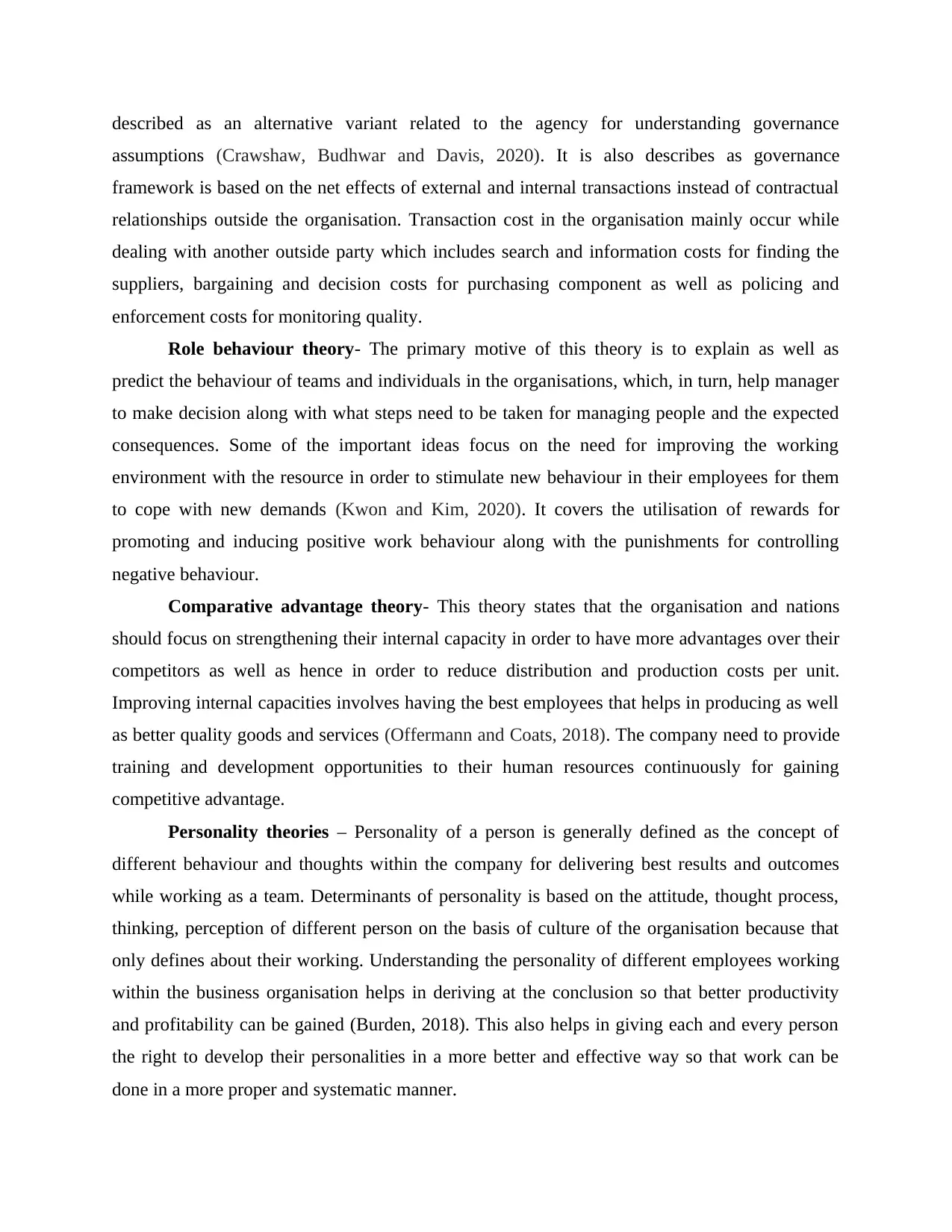
described as an alternative variant related to the agency for understanding governance
assumptions (Crawshaw, Budhwar and Davis, 2020). It is also describes as governance
framework is based on the net effects of external and internal transactions instead of contractual
relationships outside the organisation. Transaction cost in the organisation mainly occur while
dealing with another outside party which includes search and information costs for finding the
suppliers, bargaining and decision costs for purchasing component as well as policing and
enforcement costs for monitoring quality.
Role behaviour theory- The primary motive of this theory is to explain as well as
predict the behaviour of teams and individuals in the organisations, which, in turn, help manager
to make decision along with what steps need to be taken for managing people and the expected
consequences. Some of the important ideas focus on the need for improving the working
environment with the resource in order to stimulate new behaviour in their employees for them
to cope with new demands (Kwon and Kim, 2020). It covers the utilisation of rewards for
promoting and inducing positive work behaviour along with the punishments for controlling
negative behaviour.
Comparative advantage theory- This theory states that the organisation and nations
should focus on strengthening their internal capacity in order to have more advantages over their
competitors as well as hence in order to reduce distribution and production costs per unit.
Improving internal capacities involves having the best employees that helps in producing as well
as better quality goods and services (Offermann and Coats, 2018). The company need to provide
training and development opportunities to their human resources continuously for gaining
competitive advantage.
Personality theories – Personality of a person is generally defined as the concept of
different behaviour and thoughts within the company for delivering best results and outcomes
while working as a team. Determinants of personality is based on the attitude, thought process,
thinking, perception of different person on the basis of culture of the organisation because that
only defines about their working. Understanding the personality of different employees working
within the business organisation helps in deriving at the conclusion so that better productivity
and profitability can be gained (Burden, 2018). This also helps in giving each and every person
the right to develop their personalities in a more better and effective way so that work can be
done in a more proper and systematic manner.
assumptions (Crawshaw, Budhwar and Davis, 2020). It is also describes as governance
framework is based on the net effects of external and internal transactions instead of contractual
relationships outside the organisation. Transaction cost in the organisation mainly occur while
dealing with another outside party which includes search and information costs for finding the
suppliers, bargaining and decision costs for purchasing component as well as policing and
enforcement costs for monitoring quality.
Role behaviour theory- The primary motive of this theory is to explain as well as
predict the behaviour of teams and individuals in the organisations, which, in turn, help manager
to make decision along with what steps need to be taken for managing people and the expected
consequences. Some of the important ideas focus on the need for improving the working
environment with the resource in order to stimulate new behaviour in their employees for them
to cope with new demands (Kwon and Kim, 2020). It covers the utilisation of rewards for
promoting and inducing positive work behaviour along with the punishments for controlling
negative behaviour.
Comparative advantage theory- This theory states that the organisation and nations
should focus on strengthening their internal capacity in order to have more advantages over their
competitors as well as hence in order to reduce distribution and production costs per unit.
Improving internal capacities involves having the best employees that helps in producing as well
as better quality goods and services (Offermann and Coats, 2018). The company need to provide
training and development opportunities to their human resources continuously for gaining
competitive advantage.
Personality theories – Personality of a person is generally defined as the concept of
different behaviour and thoughts within the company for delivering best results and outcomes
while working as a team. Determinants of personality is based on the attitude, thought process,
thinking, perception of different person on the basis of culture of the organisation because that
only defines about their working. Understanding the personality of different employees working
within the business organisation helps in deriving at the conclusion so that better productivity
and profitability can be gained (Burden, 2018). This also helps in giving each and every person
the right to develop their personalities in a more better and effective way so that work can be
done in a more proper and systematic manner.
Paraphrase This Document
Need a fresh take? Get an instant paraphrase of this document with our AI Paraphraser
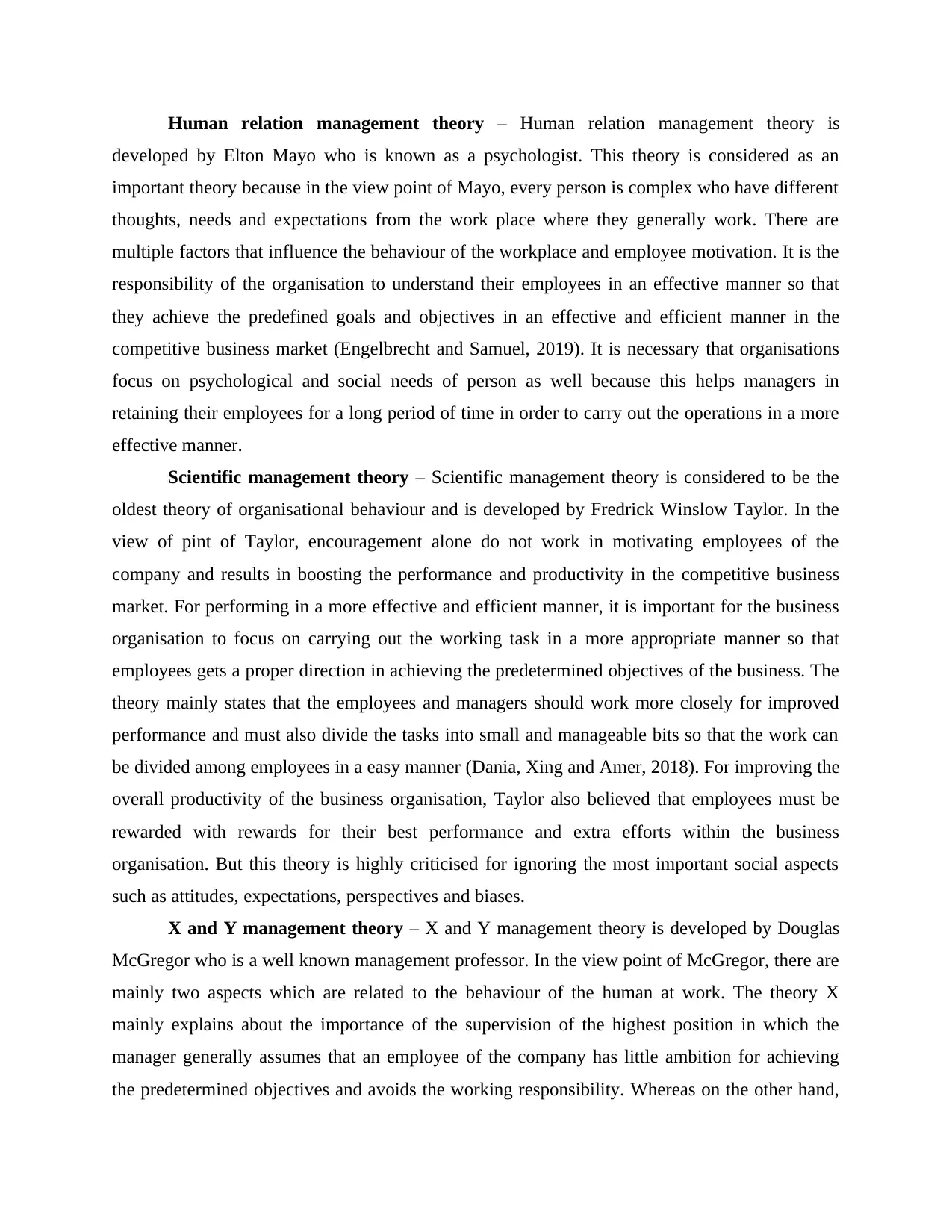
Human relation management theory – Human relation management theory is
developed by Elton Mayo who is known as a psychologist. This theory is considered as an
important theory because in the view point of Mayo, every person is complex who have different
thoughts, needs and expectations from the work place where they generally work. There are
multiple factors that influence the behaviour of the workplace and employee motivation. It is the
responsibility of the organisation to understand their employees in an effective manner so that
they achieve the predefined goals and objectives in an effective and efficient manner in the
competitive business market (Engelbrecht and Samuel, 2019). It is necessary that organisations
focus on psychological and social needs of person as well because this helps managers in
retaining their employees for a long period of time in order to carry out the operations in a more
effective manner.
Scientific management theory – Scientific management theory is considered to be the
oldest theory of organisational behaviour and is developed by Fredrick Winslow Taylor. In the
view of pint of Taylor, encouragement alone do not work in motivating employees of the
company and results in boosting the performance and productivity in the competitive business
market. For performing in a more effective and efficient manner, it is important for the business
organisation to focus on carrying out the working task in a more appropriate manner so that
employees gets a proper direction in achieving the predetermined objectives of the business. The
theory mainly states that the employees and managers should work more closely for improved
performance and must also divide the tasks into small and manageable bits so that the work can
be divided among employees in a easy manner (Dania, Xing and Amer, 2018). For improving the
overall productivity of the business organisation, Taylor also believed that employees must be
rewarded with rewards for their best performance and extra efforts within the business
organisation. But this theory is highly criticised for ignoring the most important social aspects
such as attitudes, expectations, perspectives and biases.
X and Y management theory – X and Y management theory is developed by Douglas
McGregor who is a well known management professor. In the view point of McGregor, there are
mainly two aspects which are related to the behaviour of the human at work. The theory X
mainly explains about the importance of the supervision of the highest position in which the
manager generally assumes that an employee of the company has little ambition for achieving
the predetermined objectives and avoids the working responsibility. Whereas on the other hand,
developed by Elton Mayo who is known as a psychologist. This theory is considered as an
important theory because in the view point of Mayo, every person is complex who have different
thoughts, needs and expectations from the work place where they generally work. There are
multiple factors that influence the behaviour of the workplace and employee motivation. It is the
responsibility of the organisation to understand their employees in an effective manner so that
they achieve the predefined goals and objectives in an effective and efficient manner in the
competitive business market (Engelbrecht and Samuel, 2019). It is necessary that organisations
focus on psychological and social needs of person as well because this helps managers in
retaining their employees for a long period of time in order to carry out the operations in a more
effective manner.
Scientific management theory – Scientific management theory is considered to be the
oldest theory of organisational behaviour and is developed by Fredrick Winslow Taylor. In the
view of pint of Taylor, encouragement alone do not work in motivating employees of the
company and results in boosting the performance and productivity in the competitive business
market. For performing in a more effective and efficient manner, it is important for the business
organisation to focus on carrying out the working task in a more appropriate manner so that
employees gets a proper direction in achieving the predetermined objectives of the business. The
theory mainly states that the employees and managers should work more closely for improved
performance and must also divide the tasks into small and manageable bits so that the work can
be divided among employees in a easy manner (Dania, Xing and Amer, 2018). For improving the
overall productivity of the business organisation, Taylor also believed that employees must be
rewarded with rewards for their best performance and extra efforts within the business
organisation. But this theory is highly criticised for ignoring the most important social aspects
such as attitudes, expectations, perspectives and biases.
X and Y management theory – X and Y management theory is developed by Douglas
McGregor who is a well known management professor. In the view point of McGregor, there are
mainly two aspects which are related to the behaviour of the human at work. The theory X
mainly explains about the importance of the supervision of the highest position in which the
manager generally assumes that an employee of the company has little ambition for achieving
the predetermined objectives and avoids the working responsibility. Whereas on the other hand,
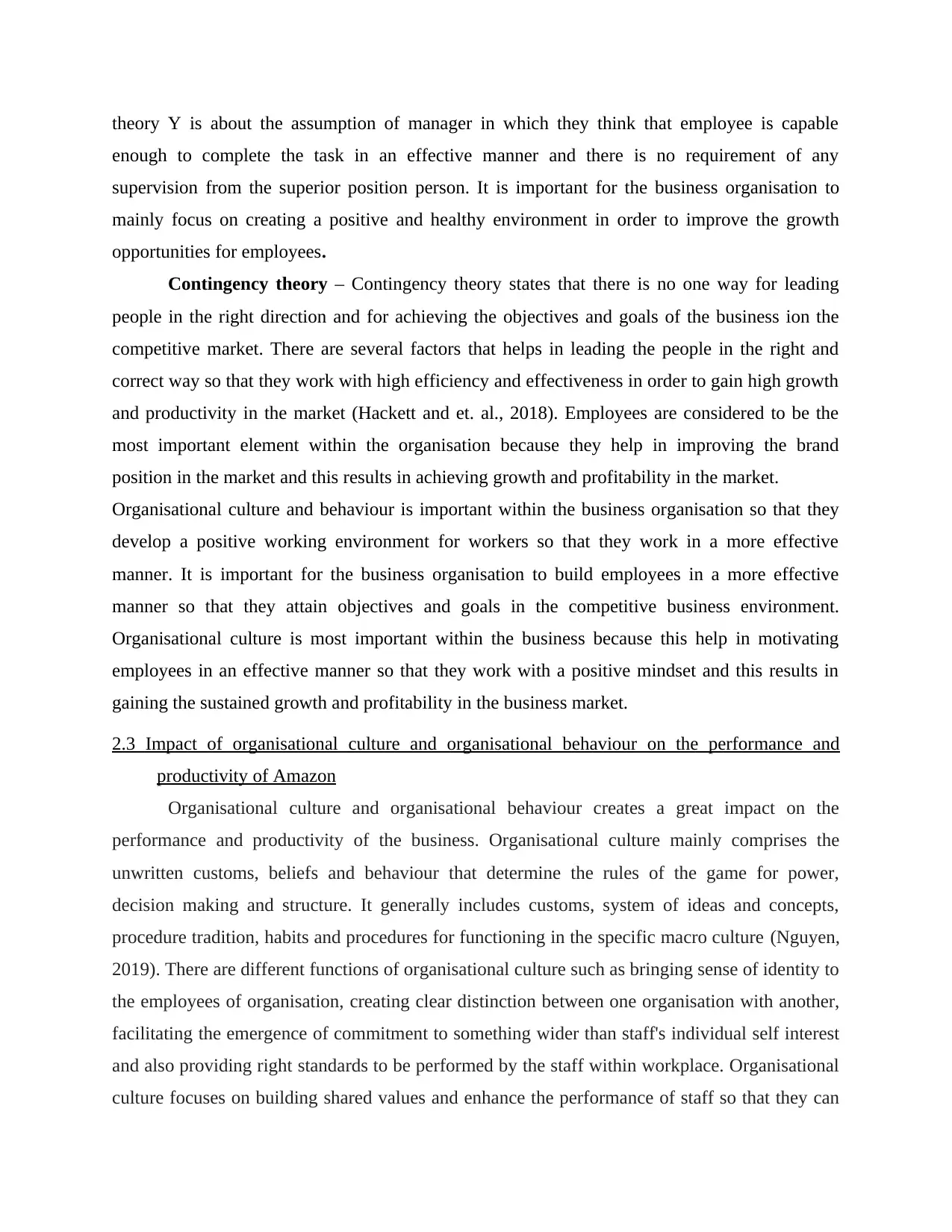
theory Y is about the assumption of manager in which they think that employee is capable
enough to complete the task in an effective manner and there is no requirement of any
supervision from the superior position person. It is important for the business organisation to
mainly focus on creating a positive and healthy environment in order to improve the growth
opportunities for employees.
Contingency theory – Contingency theory states that there is no one way for leading
people in the right direction and for achieving the objectives and goals of the business ion the
competitive market. There are several factors that helps in leading the people in the right and
correct way so that they work with high efficiency and effectiveness in order to gain high growth
and productivity in the market (Hackett and et. al., 2018). Employees are considered to be the
most important element within the organisation because they help in improving the brand
position in the market and this results in achieving growth and profitability in the market.
Organisational culture and behaviour is important within the business organisation so that they
develop a positive working environment for workers so that they work in a more effective
manner. It is important for the business organisation to build employees in a more effective
manner so that they attain objectives and goals in the competitive business environment.
Organisational culture is most important within the business because this help in motivating
employees in an effective manner so that they work with a positive mindset and this results in
gaining the sustained growth and profitability in the business market.
2.3 Impact of organisational culture and organisational behaviour on the performance and
productivity of Amazon
Organisational culture and organisational behaviour creates a great impact on the
performance and productivity of the business. Organisational culture mainly comprises the
unwritten customs, beliefs and behaviour that determine the rules of the game for power,
decision making and structure. It generally includes customs, system of ideas and concepts,
procedure tradition, habits and procedures for functioning in the specific macro culture (Nguyen,
2019). There are different functions of organisational culture such as bringing sense of identity to
the employees of organisation, creating clear distinction between one organisation with another,
facilitating the emergence of commitment to something wider than staff's individual self interest
and also providing right standards to be performed by the staff within workplace. Organisational
culture focuses on building shared values and enhance the performance of staff so that they can
enough to complete the task in an effective manner and there is no requirement of any
supervision from the superior position person. It is important for the business organisation to
mainly focus on creating a positive and healthy environment in order to improve the growth
opportunities for employees.
Contingency theory – Contingency theory states that there is no one way for leading
people in the right direction and for achieving the objectives and goals of the business ion the
competitive market. There are several factors that helps in leading the people in the right and
correct way so that they work with high efficiency and effectiveness in order to gain high growth
and productivity in the market (Hackett and et. al., 2018). Employees are considered to be the
most important element within the organisation because they help in improving the brand
position in the market and this results in achieving growth and profitability in the market.
Organisational culture and behaviour is important within the business organisation so that they
develop a positive working environment for workers so that they work in a more effective
manner. It is important for the business organisation to build employees in a more effective
manner so that they attain objectives and goals in the competitive business environment.
Organisational culture is most important within the business because this help in motivating
employees in an effective manner so that they work with a positive mindset and this results in
gaining the sustained growth and profitability in the business market.
2.3 Impact of organisational culture and organisational behaviour on the performance and
productivity of Amazon
Organisational culture and organisational behaviour creates a great impact on the
performance and productivity of the business. Organisational culture mainly comprises the
unwritten customs, beliefs and behaviour that determine the rules of the game for power,
decision making and structure. It generally includes customs, system of ideas and concepts,
procedure tradition, habits and procedures for functioning in the specific macro culture (Nguyen,
2019). There are different functions of organisational culture such as bringing sense of identity to
the employees of organisation, creating clear distinction between one organisation with another,
facilitating the emergence of commitment to something wider than staff's individual self interest
and also providing right standards to be performed by the staff within workplace. Organisational
culture focuses on building shared values and enhance the performance of staff so that they can
⊘ This is a preview!⊘
Do you want full access?
Subscribe today to unlock all pages.

Trusted by 1+ million students worldwide
1 out of 24
Related Documents
Your All-in-One AI-Powered Toolkit for Academic Success.
+13062052269
info@desklib.com
Available 24*7 on WhatsApp / Email
![[object Object]](/_next/static/media/star-bottom.7253800d.svg)
Unlock your academic potential
Copyright © 2020–2025 A2Z Services. All Rights Reserved. Developed and managed by ZUCOL.





